Improvement of Contused Spinal Cord in Rats by Cholinergic-like Neuron Therapy
- PMID: 23682324
- PMCID: PMC3652499
- DOI: 10.5812/ircmj.7653
Improvement of Contused Spinal Cord in Rats by Cholinergic-like Neuron Therapy
Abstract
Background: Disability in spinal cord injury is an important medical problem, and cell transplantation is considered as an option for the treatment.
Objectives: The purpose of this study is to use bone marrow stromal cells (BMSCs) derived cholinergic neuron-like cells (CNL) in order to ameliorate the contusion model of spinal cord injury in rats.
Materials and methods: The CNLs were produced by pre inducing BMSCs with β-mercaptoethanol (BME) followed by inducing with nerve growth factor (NGF). The cells were immunoreactive to neurofilament 200, NeuN, synaptophysin, synapsin, microtubule associated protein-2 and choline acetyl transferase (ChAT). The CNL were transplanted in contused rats (CR), which were sacrificed after 12 weeks.
Results: The results showed that BBB test showed an improvement in the CR, while the quantitative analysis showed that the improvement rate was higher in the rats treated with CNL than those treated with BMSCs only or the untreated animals, similar results were noticed in the improvement index. Immunohistochemical analysis of the tissue section prepared from the CR showed that the transplanted cells were engrafted and integrated in the traumatized spinal cord. The morphometric analysis showed that the volume density of the cavity in the CNL treated rats was significantly lower than that of the untreated ones, while the spinal tissue regeneration index was significantly higher.
Conclusions: The conclusion of the study is that CNL can improve the injured spinal cord.
Keywords: Cholinergic Neurons; Contusions; Spinal Cord Injuries; Tissue Therapy.
Figures

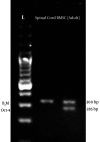
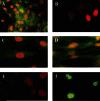
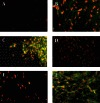

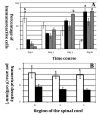
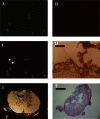

Similar articles
-
Transdifferentiation of bone marrow stromal cells into cholinergic neuronal phenotype: a potential source for cell therapy in spinal cord injury.Cytotherapy. 2009;11(2):137-52. doi: 10.1080/14653240802716582. Cytotherapy. 2009. PMID: 19253075
-
Improvement of contusive spinal cord injury in rats by co-transplantation of gamma-aminobutyric acid-ergic cells and bone marrow stromal cells.Cytotherapy. 2013 Sep;15(9):1073-85. doi: 10.1016/j.jcyt.2013.05.002. Epub 2013 Jun 25. Cytotherapy. 2013. PMID: 23806239
-
Reduction of cystic cavity, promotion of axonal regeneration and sparing, and functional recovery with transplanted bone marrow stromal cell-derived Schwann cells after contusion injury to the adult rat spinal cord.J Neurosurg Spine. 2008 Dec;9(6):600-10. doi: 10.3171/SPI.2008.9.08135. J Neurosurg Spine. 2008. PMID: 19035756
-
Bone marrow mesenchymal stem cells stimulated with low-intensity pulsed ultrasound: Better choice of transplantation treatment for spinal cord injury: Treatment for SCI by LIPUS-BMSCs transplantation.CNS Neurosci Ther. 2019 Apr;25(4):496-508. doi: 10.1111/cns.13071. Epub 2018 Oct 8. CNS Neurosci Ther. 2019. PMID: 30294904 Free PMC article.
-
Improvement of spinal contusion model by cotransplanting bone marrow stromal cells and induced BMSCs into oligodendrocytes-like cells.J Neurosurg Sci. 2017 Oct;61(5):486-494. doi: 10.23736/S0390-5616.16.03061-7. Epub 2014 Oct 6. J Neurosurg Sci. 2017. PMID: 25283064
Cited by
-
Trans-Differentiation of Human Dental Pulp Stem Cells Into Cholinergic-Like Neurons Via Nerve Growth Factor.Basic Clin Neurosci. 2019 Nov-Dec;10(6):609-617. doi: 10.32598/bcn.10.6.609. Epub 2019 Nov 1. Basic Clin Neurosci. 2019. PMID: 32477478 Free PMC article.
-
The change tendency of PI3K/Akt pathway after spinal cord injury.Am J Transl Res. 2015 Nov 15;7(11):2223-32. eCollection 2015. Am J Transl Res. 2015. PMID: 26807170 Free PMC article.
-
Evaluating Effect of Mesenchymal Stem Cells on Expression of TLR2 and TLR4 in Mouse DCs.Adv Pharm Bull. 2016 Jun;6(2):179-86. doi: 10.15171/apb.2016.025. Epub 2016 Jun 30. Adv Pharm Bull. 2016. PMID: 27478779 Free PMC article.
-
Transplantation of neurotrophin-3-transfected bone marrow mesenchymal stem cells for the repair of spinal cord injury.Neural Regen Res. 2014 Aug 15;9(16):1520-4. doi: 10.4103/1673-5374.139478. Neural Regen Res. 2014. PMID: 25317169 Free PMC article.
References
-
- Henon PR. Human embryonic or adult stem cells: an overview on ethics and perspectives for tissue engineering. Adv Exp Med Biol. 2003;534:27–45. - PubMed
-
- Newman MB, Davis CD, Kuzmin-Nichols N, Sanberg PR. Human umbilical cord blood (HUCB) cells for central nervous system repair. Neurotox Res. 2003;5(5):355–68. - PubMed
LinkOut - more resources
Full Text Sources
Other Literature Sources
